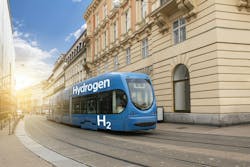Turning the Corner: $46M DOE Funding Notice Latest in Hydrogen Fuel Cell Acceleration
Following the momentum of several new hydrogen fuel cell announcements in the private sector, the federal government is accelerating its funding commitment to H2 in the transportation and power generation sectors.
The U.S. Department of Energy (DOE) has released a notice of funding opportunity (NOFO) for up to $46 million to accelerate the research, development, and demonstration (RD&D) of more affordable clean-hydrogen and fuel cell technologies.
Projects funded under the NOFO are expected not only to improve the performance of technologies for hydrogen production, hydrogen infrastructure, and fuel cells, but also demonstrate hydrogen and fuel cells in a new, high-impact application. The efforts are part of the Biden-Harris administration's coordinated whole of government approach to advancing clean hydrogen, as led by the Hydrogen Interagency Task Force.
Energy dense path to net zero goals
Hydrogen (which has the chemical formula H2) does not contain carbon in its chain and does not emit CO2 when combusted. Fuel cell technologies convert fuels like H2 or natural gas into electricity via an electrochemical process, with the only emissions being a small amount of water.
The DOE has gotten behind hydrogen infrastructure development as one of the energy-dense paths to net zero emissions goals. In March, DOE announced $750 million in funding for 52 projects aimed at working to reduce the cost of clean hydrogen and better develop H2 infrastructure.
The relatively current estimate of cost for producing hydrogen is close to US$20 per kilogram (kg). A metric ton of H2 could generate the electricity equivalent of about 33 MWh.
The Biden Administrations Inflation Reduction Act also allocated more than $1 billion toward hydrogen infrastructure development.
Advancing and demonstrating hydrogen and fuel cell technologies will help drive decarbonization across sectors like heavy-duty transportation and industrial and chemical processes, and facilitate the idea highlighted in the U.S. National Clean Hydrogen Strategy and Roadmap of affordable clean hydrogen for a net-zero-carbon future and a sustainable, resilient, and equitable economy.
DOE's Hydrogen and Fuel Cell Technologies Office (HFTO) will administer the NOFO, focusing on scaling up advanced photoelectrochemical hydrogen-production processes, improving materials for hydrogen infrastructure, developing critical components for fuel cells in heavy-duty transportation applications, and demonstrating domestic hydrogen fuel cell electric motorcoach buses.
Activities funded by the NOFO will support and strengthen the long-term viability of DOE's Regional Clean Hydrogen Hubs (H2Hubs) and other commercial-scale hydrogen installations by improving key technologies, spurring deployment, and helping industry achieve economies of scale.
The NOFO will fund projects under the following topic areas:
- Topic 1: Photoelectrochemical (PEC) Water Splitting Device Scale Up
- Topic 2: High-Performance Materials for Hydrogen Service, Including Cryogenic and/or High-Pressure Conditions
- Topic 3: Sustainable High-Temperature Proton Exchange Membranes and Ionomers for Heavy-Duty Transportation Applications
- Topic 4: Domestic Hydrogen Fuel Cell Electric Motorcoach Bus Development and Demonstration
Future is now for H2FC adoption
Regarding the last-mentioned topic on fuel cell bus and Class 8 truck development, EnergyTech has featured recent stories on H2FC projects with San Mateo Transit in California, adult beverage firm Diageo in Illinois and Nestle Purina Pet Care, also in California.
Research firm McKinsey anticipates that global clean hydrogen demand could grow multi-fold to approximately 585 metric tons per year by 2050. Current “gray hydrogen” production is already close to 90 million tons per year, used mainly in industrial processes.
Gray hydrogen is separated from methane natural gas via processes such as steam reforming. To be considered truly green hydrogen, it should mostly be generated by electrolyzers powered by carbon-free resources such as solar, wind, hydrogen or nuclear.
About the Author
Rod Walton, EnergyTech Managing Editor
Managing Editor
For EnergyTech editorial inquiries, please contact Managing Editor Rod Walton at [email protected].
Rod Walton has spent 17 years covering the energy industry as a newspaper and trade journalist. He formerly was energy writer and business editor at the Tulsa World. Later, he spent six years covering the electricity power sector for Pennwell and Clarion Events. He joined Endeavor and EnergyTech in November 2021.
Walton earned his Bachelors degree in journalism from the University of Oklahoma. His career stops include the Moore American, Bartlesville Examiner-Enterprise, Wagoner Tribune and Tulsa World.
EnergyTech is focused on the mission critical and large-scale energy users and their sustainability and resiliency goals. These include the commercial and industrial sectors, as well as the military, universities, data centers and microgrids. The C&I sectors together account for close to 30 percent of greenhouse gas emissions in the U.S.
He was named Managing Editor for Microgrid Knowledge and EnergyTech starting July 1, 2023
Many large-scale energy users such as Fortune 500 companies, and mission-critical users such as military bases, universities, healthcare facilities, public safety and data centers, shifting their energy priorities to reach net-zero carbon goals within the coming decades. These include plans for renewable energy power purchase agreements, but also on-site resiliency projects such as microgrids, combined heat and power, rooftop solar, energy storage, digitalization and building efficiency upgrades.

